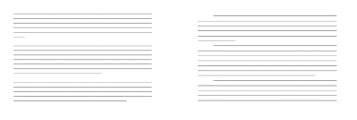A paragraph is one structural unit of text that consists of several sentences relating to one main idea. Therefore, just like a whole document, this unit should be self-contained, with a clear, logical beginning, middle and end.
In Summary
|
There are two essential characteristics of a paragraph to make it successful:
| unity: the paragraph is made up of separate elements, the sentences, which should effortlessly form the whole.
coherence: the paragraph’s content is logically organized and connected |
The common denominator for these characteristics is the topic sentence, which should control the paragraph’s information.
Topic Sentence
The topic sentence tells the reader what the paragraph is about, i.e. it summarizes the main idea being expressed. All other sentences in the paragraph further develop and exemplify what is stated in the topic sentence. Read the paragraph below about inspiration from living systems. The first sentence is underlined because it is the topic sentence that controls the paragraph.
“In the past few years, a growing number of engineers have been seeking inspiration from living systems-birds, insects, and other biological models-in an effort to produce breakthroughs in vehicle concepts, reshape our frame of reference, and change the definition of what is possible. Knowledge of the form and function of biological systems is not used as a blueprint, but as an architectural and operational analog. In many cases, we are finding that nature’s basic design concepts-and, in some cases, the actual designs-can be applied to aerospace systems.” (Goldin, Venner and Noor, 2001, p.48)
The topic sentence controls the paragraph in that it dictates what can and should be included in the paragraph. Every sentence in the paragraph must be related to the topic sentence, and no irrelevant information should be included. This ensures that the paragraph displays unity.
In most paragraphs, the topic sentence is placed at the beginning or very near the beginning. It is true, however, that some variation of this basic structure can be found. In some cases, it is the concluding sentence. Still, it is a good idea to try to start each paragraph with a topic sentence to allow for easier reading.
Beyond the topic sentence and length
Once the central theme has been introduced by the topic sentence, a paragraph needs to develop it, and in order to do so effectively, most well written paragraphs consist of three sentences or more. Only rarely can one-sentence or two-sentence paragraphs be found, and this is more usual in fiction. Single sentence paragraphs make the document choppy with the result that readers are unable to understand the sentences and the reasoning that belong together. If you find you have a paragraph with just one sentence, consider whether or not the facts in this sentence could not be integrated into a nearby paragraph. On the other hand, if you have a paragraph that is very long, consider whether or not you are truly developing one thought, or if perhaps you have more than one theme and can split the paragraph into two or more paragraphs.
Paragraph Format
By dividing reports into paragraphs, the writer communicates to the reader how the report contents are connected. The images below illustrate how paragraphs are either marked by a white gap (image on left) or by means of first line indentation (image on right).
And finally, in order to make the topic sentence, supporting idea and example sentences work together as a paragraph, for the reader to comprehend the text effortlessly, cohesive devices are essential. For more information on that and other related aspects, see the section Coherence and Cohesion.